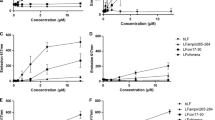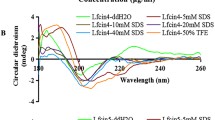Abstract
Lactoferricin B (LfcinB), a 25 residue peptide derived from the N-terminal of bovine lactoferrin (bLF), causes depolarization of the cytoplasmic membrane in susceptible bacteria. Its mechanism of action, however, still needs to be elucidated. In the present study, synthetic LfcinB (without a disulfide bridge) and LfcinB (C–C; with a disulfide bridge) as well as three derivatives with 15-, 11- and 9-residue peptides were prepared to investigate their antimicrobial nature and mechanisms. The antimicrobial properties were measured via minimum inhibitory concentration (MIC) determinations, killing kinetics assays and synergy testing, and hemolytic activities were assessed by hemoglobin release. Finally, the morphology of peptide-treated bacteria was determined by atomic force microscopy (AFM). We found that there was no difference in MICs between LfcinB and LfcinB (C–C). Among the derivatives, only LfcinB15 maintained nearly the same level as LfcinB, in the MIC range of 16–128 μg/ml, and the MICs of LfcinB11 (64–256 μg/ml) were 4 times more than LfcinB, while LfcinB9 exhibited the lowest antimicrobial activity. When treated at MIC for 1 h, many blebs were formed and holes of various sizes appeared on the cell surface, but the cell still maintained its integrity. This suggested that LfcinB had a major permeability effect on the cytoplasmic membrane of both Gram-positive and Gram-negative bacteria, which also indicated it may be a possible intracellular target. Among the tested antibiotics, aureomycin increased the bactericidal activity of LfcinB against E. coli, S. aureus and P. aeruginosa, but neomycin did not have such an effect. We also found that the combination of cecropin A and LfcinB had synergistic effects against E. coli.




Similar content being viewed by others
References
Bellamy W, Takase M, Wakabayashi H et al (1992) Antibacterial spectrum of lactoferricin B, a potent bactericidal peptide derived from the N-terminal region of bovine lactoferrin. J Appl Bacteriol 73(6):472–479
Boman HG (2003) Antibacterial peptides: basic facts and emerging concepts. J Intern Med 254(3):197–215
Eliassen LT, Berge G, Leknessund A et al (2006) The antimicrobial peptide, lactoferricin B, is cytotoxic to neuroblastoma cells in vitro and inhibits xenograft growth in vivo. Int J Cancer 119(3):493–500
Giacometti A, Cirioni O, Prete MS et al (2000) Combination studies between polycationic peptides and clinically used antibiotics against Gram-positive and Gram-negative bacteria. Peptides 21(8):1155–1160
Gifford JL, Hunter HN, Vogel HJ (2005) Lactoferricin: a lactoferrin-derived peptide with antimicrobial, antiviral, antitumor and immunological properties. Cell Mol Life Sci 62(22):2588–2598
Groenink J, Walgreen-Weterings E, van’t Hof W et al (1999) Cationic amphipathic peptides, derived from bovine and human lactoferrins, with antimicrobial activity against oral pathogens. FEMS Microbiol Lett 179(2):217–222
Hancock RE, Sahl HG (2006) Antimicrobial and host-defense peptides as new anti-infective therapeutic strategies. Nat Biotechnol 24(12):1551–1557
Haukland HH, Ulvatne H, Sandvik K et al (2001) The antimicrobial peptides lactoferricin B and magainin 2 cross over the bacterial cytoplasmic membrane and reside in the cytoplasm. FEBS Lett 208(3):389–393
Hwang PM, Zhou N, Shan X et al (1998) Three-dimensional solution structure of lactoferricin B, an antimicrobial peptide derived from bovine lactoferrin. Biochemistry 37(12):4288–4298
Isidra Recio, Servaas Visser (2000) Antibacterial and binding characteristics of bovine, ovine and caprine lactoferricins: a comparative study. Int Dairy J 10(9):597–605
Jenssen H, Adersen JH, Uhlin-Hansen L et al (2004) Anti-HSV activity of lactoferricin analogues is only partly related to their affinity for heparin sulfate. Antivir Res 61(2):101–109
Li A, Lee PY, Ho B et al (2007) Atomic force microscopy study of the antimicrobial action of Sushi peptides on Gram negative bacteria. Biochim Biophys Acta 1768(3):411–418
Nguyen LT, Schibli DJ, Vogel HJ (2005) Structural studies and model membrane interactions of two peptides derived from bovine lactoferricin. J Peptide Sci 11(7):379–389
Nguyen LT, Chau JK, Perry NA et al (2010) Serum stabilities of short tryptophan- and arginine- rich antimicrobial peptide analogs. PLoS One 5(9):e12684
Orsi N (2004) The antimicrobial activity of lactoferrin: current status and perspectives. Biometals 17(3):189–196
Park CB, Kim HS, Kim SC (1998) Mechanism of action of the antimicrobial peptide buforin II: bufrrinII kills microorganisms by penetrating the cell membrane and inhibiting cellular functions. Biochem Biophys Res Commun 244(1):253–257
Schibli DJ, Hwang PM, Vogel HJ (1999) The structure of the antimicrobial active center of lactoferricin B bound to sodium dodecyl sulfate micelles. FEBS Lett 446(2–3):213–217
Tolokh IS, Vivcharuk V, Tomberli B, et al (2009) Binding free energy and counterion release for adsorption of the antimicrobial peptide lactoferricin B on a POPG membrane. Phys Rev E Stat Nonlin Soft Matter phys 80(3 Pt 1):031911
Tomita M, Takase M, Bellamy W et al (1994) A review: the active peptide of lactoferrin. Acta Paediatr Jpn 36(5):585–591
Ueta E, Tanida T, Osaki T (2001) A novel bovine lactoferrin peptide, FKCRRWQWRM, suppresses Candida cell growth and activates neutrophils. J Peptide Res 57(3):240–249
Ulvatne H, Vorland LH (2001) Bactericidal kinetics of 3 lactoferricins against Staphylococcus aureus and Escherichia coli. Scand J Infect Dis 33(7):507–511
Ulvatne H, Haukland HH, Olsvik Ø, Vorland LH (2001) Lactoferricin B causes depolarization of the cytoplasmic membrane of Escherichia coli ATCC 25922 and fusion of negatively charged liposomes. FEBS Lett 492(1–2):62–65
Ulvatne H, Samuelsen Ø, Haukland HH et al (2004) Lactoferricin B inhibits bacterial macromolecular synthesis in Escherichia coli and Bacillus subtilis. FEMS Microbiol Lett 237(2):377–384
Umeyama M, Atsushi Kira, Nishimura K et al (2006) Interactions of bovine lactoferricin with acidic phospholipids bilayers and its antimicrobial activity as studied by solid-state NMR Biochim. Biophys Acta 1758(9):1523–1528
Van der Kraan Mi, Groenink J, Nazmi K et al (2004) Lactoferrampin: a novel antimicrobial peptide in the N1-domain of bovine lactoferrin. Peptides 25(2):177–183
Vorland LH, Osbakk SA, Perstølen T et al (1999) Interference of the antimicrobial peptide lactoferricin B with the action of various antibiotics against E coli and S aureus. Scand J Infect Dis 31(2):173–177
Wakabayashi H, Matsumoto H, Hashimoto K et al (1999) N-Acylated and d enantiomer derivatives of a nonamer core peptide of lactoferricin B showing improved antimicrobial activity. Antimicrob Agents Chemother 43(5):1267–1269
Wakabayashi H, Teraguchi S, Tamura Y (2002) Increased Staphylococcus-killing activity of an antimicrobial peptide, Lactoferricin B, with minocycline and monoacylglycerol. Biosci Biotechnol Biochem 66(10):2161–2167
Zhang TN, Yang W, Liu N (2010) Effect of loop structure of bovine lactoferricin on apoptosis in Jurkat cells. Biometals 23(3):555–561
Acknowledgments
We are very grateful for the excellent technical assistance of Xinyan Han. We greatly appreciate the anonymous reviewers who helped tremendously in improving the quality of the manuscript. This work was supported by the National High Technology Research and Development Program 863 (2007AA100602).
Author information
Authors and Affiliations
Corresponding author
Rights and permissions
About this article
Cite this article
Liu, Y., Han, F., Xie, Y. et al. Comparative antimicrobial activity and mechanism of action of bovine lactoferricin-derived synthetic peptides. Biometals 24, 1069–1078 (2011). https://doi.org/10.1007/s10534-011-9465-y
Received:
Accepted:
Published:
Issue Date:
DOI: https://doi.org/10.1007/s10534-011-9465-y




